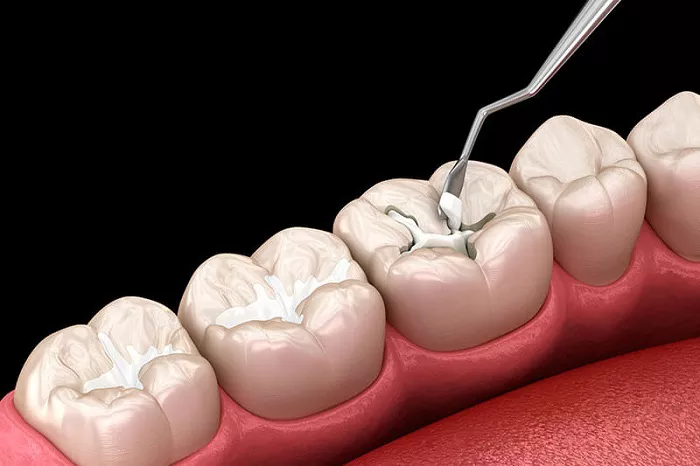Dental fillings are essential in restoring teeth that have been damaged by decay or trauma. Over the years, several types of dental fillings have emerged, each with its own unique characteristics and applications. In this article, we will explore some of the most popular dental fillings, their properties, advantages, and limitations, to help both dental professionals and patients make informed decisions.
Amalgam Fillings
Amalgam has been a long-standing option in dental restorations. It is a mixture of metals, predominantly silver, tin, copper, and mercury.
Advantages:
Strength and Durability: It can withstand significant chewing forces, making it highly suitable for posterior teeth where the bite pressure is greater. It has a proven track record of lasting for many years, often 10 – 15 years or more.
Cost-Effective: Generally, amalgam fillings are less expensive compared to some of the newer, more advanced filling materials. This makes them a viable choice for patients with budget constraints or for situations where insurance coverage may be limited.
Limitations:
Aesthetic Appearance: The silver-gray color of amalgam is not visually appealing, especially when used in anterior teeth. It can be a noticeable blemish in a patient’s smile, which may lead to self-consciousness.
Mercury Content: Although extensive research has indicated that the mercury in amalgam fillings is generally safe and remains stable within the filling, some patients may have concerns about potential mercury toxicity. However, scientific studies have not conclusively shown any significant negative health impacts from amalgam fillings in the vast majority of cases.
Composite Fillings
Composite resins are a popular choice, especially in modern dentistry. They consist of a combination of plastic and fine glass particles and are available in a wide range of tooth-colored shades.
Advantages:
Aesthetic Appeal: They can be precisely color-matched to the patient’s natural teeth, providing a seamless and natural-looking restoration. This is particularly crucial for anterior teeth, where appearance is of utmost importance.
Bonding Capability: Composite fillings chemically bond to the enamel and dentin of the tooth. This bonding not only helps in restoring the structural integrity of the tooth but also reduces the risk of microleakage, which can lead to secondary decay.
Minimal Tooth Preparation: Compared to amalgam fillings, composite fillings require less removal of healthy tooth structure. This is because they rely on the bonding process rather than just mechanical retention, thereby preserving more of the natural tooth.
Limitations:
Strength in High-Stress Areas: While composite fillings are suitable for many restorations, they may not be as durable as amalgam in posterior teeth that endure heavy chewing forces. Over time, they can wear down or chip, especially in patients with bruxism or heavy biting habits.
Discoloration: Composite fillings are prone to staining over time. Exposure to substances like coffee, tea, red wine, or tobacco can cause the filling to change color, which may affect the overall aesthetic appearance and require replacement or refinishing.
Ceramic Fillings
Ceramic fillings, such as porcelain or zirconia, have gained popularity due to their excellent aesthetic qualities.
Advantages:
Superior Aesthetics: They offer a highly natural and lifelike appearance, closely mimicking the translucency and color of natural teeth. This makes them an ideal choice for visible areas of the mouth, enhancing the overall smile esthetics.
Biocompatibility: Ceramic materials are well-tolerated by the body and have a low risk of causing allergic reactions or adverse tissue responses.
Stain Resistance: Unlike composite fillings, ceramic fillings are highly resistant to staining. They maintain their color and appearance over an extended period, even with regular exposure to staining agents.
Limitations:
Brittleness: Ceramic is relatively brittle compared to some other filling materials. In posterior teeth where high chewing forces are present, there is a risk of fracture, especially if the patient has a habit of grinding or clenching their teeth.
Cost: Ceramic fillings are more expensive than amalgam and composite fillings. The higher cost may limit their use in some patients, especially those without comprehensive dental insurance coverage.
Glass Ionomer Fillings
Glass ionomer is a unique type of filling material with distinct properties.
Advantages:
Fluoride Release: One of the significant benefits of glass ionomer fillings is their ability to release fluoride. This fluoride release helps in preventing further decay in the surrounding tooth structure, making it a good option for teeth that are at a higher risk of recurrent caries.
Suitability for Primary Teeth and Small Restorations: It is less technique-sensitive compared to some other materials and can be used in situations where moisture control is more challenging, such as in children’s primary teeth. It is also suitable for small restorations where the forces of chewing are not excessive.
Limitations:
Low Strength: Glass ionomer has relatively low compressive strength. It is not recommended for large restorations or areas where significant chewing forces are involved, as it may break or wear down quickly.
Wear Rate: It has a higher wear rate compared to other filling materials like amalgam and ceramics. This means that it may need to be replaced more frequently, especially in areas of the mouth that experience heavy use.
Conclusion
The choice of dental filling material is a complex decision that depends on multiple factors. Amalgam fillings offer strength and cost-effectiveness, while composite fillings excel in aesthetics and bonding. Ceramic fillings provide outstanding appearance and biocompatibility, and glass ionomer fillings have unique properties like fluoride release. Dental professionals must consider the location of the cavity, the patient’s aesthetic requirements, their biting habits, and cost considerations when selecting the most appropriate filling material.

